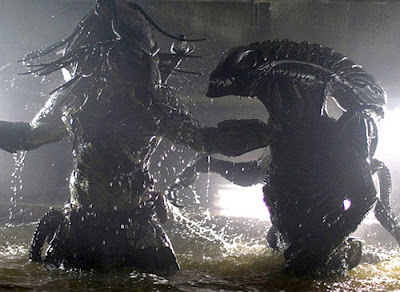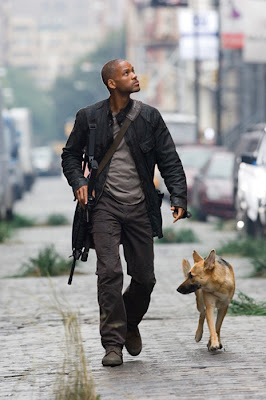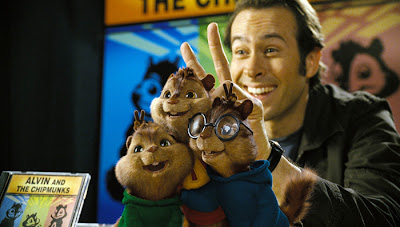
Dallas: Steven Pasquale
Kelly: Reiko Aylesworth
Morales: John Ortiz
Ricky: Johnny Lewis
Jesse: Kristen Hager
Molly: Ariel Gade
20th Century Fox presents a film directed by The Brothers Strause. Written by Shane Salerno, based on characters created by Dan O’Bannon & Ronald Shusett and Jim and John Thomas. Running time: 86 min. Rated R (for violence, gore and language).
There are times when watching movies can be down right discouraging. I shouldn’t let a movie like “Aliens vs. Predator: Requiem” get me down in a year that brought such wonderful cinema as “American Gangster”, “Zodiac”, “Grindhouse”, “Stephanie Daley”, “The Wind That Shakes the Barley”, “Eastern Promises”, “No Country for Old Men”, “Knocked Up”, and “Hairspray”. But I can’t help it. I understand that the sci-fi genre can’t hope to produce high aspirations throughout, but how could one franchise—or even two, as is the case here—have fallen so far from its original greatness.
“AVP-R” made me yearn for Ridley Scott’s patience in building tension, with his long tracking shots and the silence of space in the original “Alien”. I desired James Cameron’s maternal themes and terse action from “Aliens”. I remembered David Fincher’s moody production design and stylized camera work from “Alien 3”. The simpler but easy to follow plots of the two “Predator” films were well conceived compared to this “Requiem” mess. Even the failure of “Alien: Resurrection” aspired to be something greater than just an action contest of rubber-suited muscle. Hell, I even found some pleasure in the rudimentary gamesmanship that made up the entirety of Paul W. S. Anderson’s sub-standard “Alien vs. Predator”. But “Requiem”—a title that has no apparent meaning beyond the fact that it sounds cool—aspires to be nothing more than bad B-grade cinema.
The Brothers Strause graduate from the visual effects teams of such visually stunning pictures as “300”, “Constantine”, and “The Day After Tomorrow” to the directors’ chairs with all too typically muddied results. It seems the only knowledge they gained from their experience with visual effects over the past decade or so is that if you keep the picture very dark, the audience won’t be able to see when you’ve colored outside the lines. The aliens and the predator in this picture fight many times, and I don’t remember an action picture where I dreaded the action sequences so much. This is simply because the picture was so dark that none of the action could be followed. There was even this potentially awesome looking alien/predator hybrid, but I never got a good look at him so I’ll never know for sure.
That is not to say those Brothers Strause handled the non-action sequences any better. Shane Salerno’s script provides too many characters and never any solid reasons for them to remain in harm’s way. With a plot set for no particular reason in Crested Butte, Colorado, Salerno (“Shaft”) doles out all the typical rising death count movie character types. John Ortiz (“Miami Vice”) is terribly miscast as the small town’s reluctant sheriff. There is the affluent rich girl Jesse (Kristen Hager, “I’m Not There”) and Ricky (Johnny Lewis, “The OC” TV series), the boy from the wrong side of the tracks who wants her. Ricky’s older brother Dallas (Steven Pasquale, FX’s “Rescue Me”) is a reformed troublemaker and former friend of the sheriff. And the strong female heroine comes in the form of Kelly (Reiko Aylesworth, FOX’s “24”), a recently returned soldier from Iraq and mother to Molly (Ariel Gade, NBC’s “Invasion”).
Why the story doesn’t begin with Kelly is beyond me. Instead we are introduced to the space creatures first as the bug-like aliens break away from their captors, the predators, aboard a spacecraft that crashes in the Colorado wilderness. I believe this scene is meant to be a continuation of the final scene from the first “AVP” movie, but the alien/predator hybrid is the only reference ever made to that story.
In fact, the referencing of previous films and practices of the aliens and predators with no further explanation or purpose seems to be a theme of this movie. Like the ship’s captain in the original “Alien”, one of the characters is named Dallas. No relation between the two is ever mentioned. In the same way Ripley takes on the mother role to Newt in “Aliens”, Kelly must work to be accepted by Molly as her mother again after years away at war. But once they start dodging blows between the aliens and the predator, Molly might as well not even exist. There are scenes that reference “Alien 3” as well, including one in a hospital where the alien/predator hybrid seems to take the same interest in the pregnant women in the maternity ward that the alien took in Ripley’s pregnancy from that earlier film. But the purpose seems designed more to disgust the audience than to make any biological sense.
Perhaps the most mind-boggling reference to any of the earlier pictures in either franchise, however, comes when the predator seems to counteract his entire purpose on the planet when he kills a cop, skins him, and hangs him from a tree for the humans to discover. While this is a common practice of the predators in previous incarnations, this predator is not on Earth to hunt humans, but rather purpose re-capture the aliens and erase any trace of their existence. Why else would he be carrying around some chemical that disintegrates all living tissue with which it comes into contact. He meticulously destroys all evidence left behind by the escaped aliens, including a father and son that were impregnated by some face-sucking alien bugs, but then he leaves the cop’s corpse as a calling card. I guess a predator just can’t suppress his own nature.
I suppose The Brothers Strause are proud of their resolve as filmmakers for having the guts to kill off children in the same horrific and gory manner as any of the adults in the film. What they don’t seem to have the brains to do is look at the films from which theirs originated and demand a script that lives up to the legacy that has been bestowed upon them. When the 007 series begins to spin its wheels, MGM shakes it up with a major revamp. Fox only seems interested in milking these once valuable franchises until they are dead and buried.
Kelly: Reiko Aylesworth
Morales: John Ortiz
Ricky: Johnny Lewis
Jesse: Kristen Hager
Molly: Ariel Gade
20th Century Fox presents a film directed by The Brothers Strause. Written by Shane Salerno, based on characters created by Dan O’Bannon & Ronald Shusett and Jim and John Thomas. Running time: 86 min. Rated R (for violence, gore and language).
There are times when watching movies can be down right discouraging. I shouldn’t let a movie like “Aliens vs. Predator: Requiem” get me down in a year that brought such wonderful cinema as “American Gangster”, “Zodiac”, “Grindhouse”, “Stephanie Daley”, “The Wind That Shakes the Barley”, “Eastern Promises”, “No Country for Old Men”, “Knocked Up”, and “Hairspray”. But I can’t help it. I understand that the sci-fi genre can’t hope to produce high aspirations throughout, but how could one franchise—or even two, as is the case here—have fallen so far from its original greatness.
“AVP-R” made me yearn for Ridley Scott’s patience in building tension, with his long tracking shots and the silence of space in the original “Alien”. I desired James Cameron’s maternal themes and terse action from “Aliens”. I remembered David Fincher’s moody production design and stylized camera work from “Alien 3”. The simpler but easy to follow plots of the two “Predator” films were well conceived compared to this “Requiem” mess. Even the failure of “Alien: Resurrection” aspired to be something greater than just an action contest of rubber-suited muscle. Hell, I even found some pleasure in the rudimentary gamesmanship that made up the entirety of Paul W. S. Anderson’s sub-standard “Alien vs. Predator”. But “Requiem”—a title that has no apparent meaning beyond the fact that it sounds cool—aspires to be nothing more than bad B-grade cinema.
The Brothers Strause graduate from the visual effects teams of such visually stunning pictures as “300”, “Constantine”, and “The Day After Tomorrow” to the directors’ chairs with all too typically muddied results. It seems the only knowledge they gained from their experience with visual effects over the past decade or so is that if you keep the picture very dark, the audience won’t be able to see when you’ve colored outside the lines. The aliens and the predator in this picture fight many times, and I don’t remember an action picture where I dreaded the action sequences so much. This is simply because the picture was so dark that none of the action could be followed. There was even this potentially awesome looking alien/predator hybrid, but I never got a good look at him so I’ll never know for sure.
That is not to say those Brothers Strause handled the non-action sequences any better. Shane Salerno’s script provides too many characters and never any solid reasons for them to remain in harm’s way. With a plot set for no particular reason in Crested Butte, Colorado, Salerno (“Shaft”) doles out all the typical rising death count movie character types. John Ortiz (“Miami Vice”) is terribly miscast as the small town’s reluctant sheriff. There is the affluent rich girl Jesse (Kristen Hager, “I’m Not There”) and Ricky (Johnny Lewis, “The OC” TV series), the boy from the wrong side of the tracks who wants her. Ricky’s older brother Dallas (Steven Pasquale, FX’s “Rescue Me”) is a reformed troublemaker and former friend of the sheriff. And the strong female heroine comes in the form of Kelly (Reiko Aylesworth, FOX’s “24”), a recently returned soldier from Iraq and mother to Molly (Ariel Gade, NBC’s “Invasion”).
Why the story doesn’t begin with Kelly is beyond me. Instead we are introduced to the space creatures first as the bug-like aliens break away from their captors, the predators, aboard a spacecraft that crashes in the Colorado wilderness. I believe this scene is meant to be a continuation of the final scene from the first “AVP” movie, but the alien/predator hybrid is the only reference ever made to that story.
In fact, the referencing of previous films and practices of the aliens and predators with no further explanation or purpose seems to be a theme of this movie. Like the ship’s captain in the original “Alien”, one of the characters is named Dallas. No relation between the two is ever mentioned. In the same way Ripley takes on the mother role to Newt in “Aliens”, Kelly must work to be accepted by Molly as her mother again after years away at war. But once they start dodging blows between the aliens and the predator, Molly might as well not even exist. There are scenes that reference “Alien 3” as well, including one in a hospital where the alien/predator hybrid seems to take the same interest in the pregnant women in the maternity ward that the alien took in Ripley’s pregnancy from that earlier film. But the purpose seems designed more to disgust the audience than to make any biological sense.
Perhaps the most mind-boggling reference to any of the earlier pictures in either franchise, however, comes when the predator seems to counteract his entire purpose on the planet when he kills a cop, skins him, and hangs him from a tree for the humans to discover. While this is a common practice of the predators in previous incarnations, this predator is not on Earth to hunt humans, but rather purpose re-capture the aliens and erase any trace of their existence. Why else would he be carrying around some chemical that disintegrates all living tissue with which it comes into contact. He meticulously destroys all evidence left behind by the escaped aliens, including a father and son that were impregnated by some face-sucking alien bugs, but then he leaves the cop’s corpse as a calling card. I guess a predator just can’t suppress his own nature.
I suppose The Brothers Strause are proud of their resolve as filmmakers for having the guts to kill off children in the same horrific and gory manner as any of the adults in the film. What they don’t seem to have the brains to do is look at the films from which theirs originated and demand a script that lives up to the legacy that has been bestowed upon them. When the 007 series begins to spin its wheels, MGM shakes it up with a major revamp. Fox only seems interested in milking these once valuable franchises until they are dead and buried.







